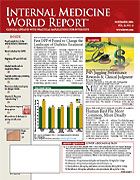Publication
Article
Internal Medicine World Report
Role of ras Inhibition in Prevention of Diabetes Still Tenuous
Author(s):
Los Angeles?Despite a large volume of circumstantial evidence, modulation of the renin-angiotensin system (RAS) as a means of preventing diabetes requires further study, especially clinical trials that have diabetes as a primary end point.?
Interpretation or extrapolation of the current data on the issue has to be done with caution, said Laura Shane-McWhorter, PharmD, of the ?University of Utah Health Sciences Center, at the American Association of Diabetes Educators meeting. Most of the data collected to date have come from unplanned, post hoc analyses. In addition, the definition of diabetes has varied among the studies.
"Depending on when the study was published, the criteria for diagnosing diabetes was different," she said. "Earlier studies used the old definition of greater than 140 [mg/dL]. Newer studies used the current definition of higher than 126. Another issue relates to use of other medications. Was the result for these renin-angiotensin system modulators positive because you have negative effects with diuretics and beta-blockers, which tend to adversely affect blood glucose? What about the role of calcium channel blockers? It turns out that calcium channel blockers have some benefits. In some of the trials, patients might have been on concomitant calcium channel blockers."
N Engl J Med
The recent publication of DREAM (Diabetes Reduction Assessment with Ramipril and Rosiglitazone Medication) study (. 2006; 355:1551-1562) showed that treatment with the angiotensin-converting-enzyme?(ACE) inhibitor ramipril did not reduce the risk of new-onset diabetes in patients with impaired fasting glucose or impaired glucose tolerance (IGT). However, ramipril significantly increased the rate of regression to normoglycemia compared with placebo.
Diabetes Care
N Engl J Med
The search for strategies to prevent diabetes has been going on for at least 2 decades. One study showed that a combination of diet and exercise reduced the incidence of diabetes by 42% over 6 years compared with a control in 577 patients with IGT (. 1997; 20:537-544). A few years later, Finnish investigators reported a 58% reduction in diabetes incidence over 4 years in middle-aged patients with IGT who were randomized to lifestyle interventions (. 2001; 344: 1343-1350).
N Engl J Med
Diabetes
The Diabetes Prevention Program trial found weight loss and exercise to be significantly more effective than metformin for preventing diabetes (. 2002; 346:393-403). And troglitazone was shown to significantly reduce the risk of diabetes compared with placebo in a group of Hispanic women with a history of gestational diabetes (. 2002; 51:2796-2803). The beneficial effects appeared to be related to ameliorating insulin resistance, which helps preserve pancreatic beta-cell function.
Drugs
J Hypertension
Multiple studies have yielded evidence that inhibition of RAS with ACE inhibitors or angiotensin receptor blockers (ARBs) can prevent diabetes in high-risk patients. The risk reduction has been attributed to a host of potential mechanisms, which collectively point to preservation of beta-cell function, enhancement of insulin sensitivity, changes in microcirculation, and changes in potassium and magnesium (. 2004; 64:2537-2565; . 2005; 23:463-473).
The HOPE (Heart Outcomes Prevention Evaluation) trial raised awareness of the possibility that treatment with an ACE inhibitor or ARB might reduce the risk of diabetes. Patients treated with ramipril had a 34% reduction in the relative risk of diabetes compared with placebo. Results of ALLHAT (Antihypertensive and Lipid-Lowering Treatment to Prevent Heart Attack Trial) showed that patients randomized to the ACE inhibitor lisinopril had a 30% lower incidence of diabetes compared with those treated with a diuretic and a 17% lower incidence compared with those treated with amlodipine, a calcium channel blocker.
Lancet
Circulation
Additional studies have shown a reduced risk of new-onset diabetes in patients treated with the ARBs losartan, valsartan, and candesartan, with a magnitude of reduction ranging from 20% to 25% in each trial (. 2002; 359:995-1003, 2004; 363:2022-2031; . 2005; 112:48-53).
As noted by Dr Shane-McWhorter, data on the association between RAS inhibition and reduced diabetes risk has a number of limitations, not the least of which is the retrospective nature of much of the information. The mixed results of the DREAM trial underscore the need for controlled trials.
The ongoing NAVIGATOR (Nateglinide and Valsartan in Impaired Glucose Tolerance Outcomes Research) trial represents a new effort. NAVIGATOR investigators have screened 43,000 patients and have randomized 9000 with IGT who are at high risk for cardiovascular disease. This trial is expected to be completed in 2008.





